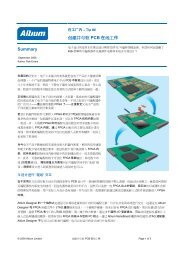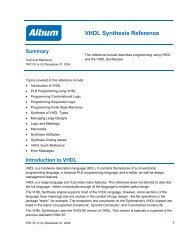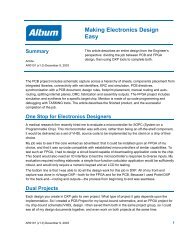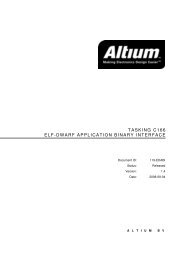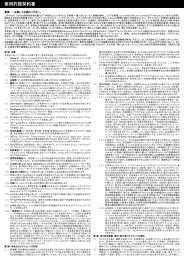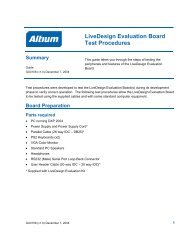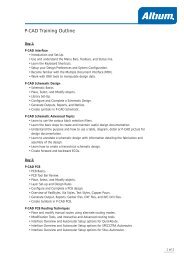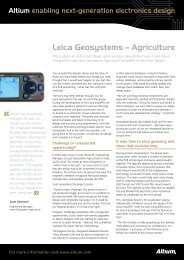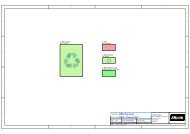Create successful ePaper yourself
Turn your PDF publications into a flip-book with our unique Google optimized e-Paper software.
<strong>Moving</strong> <strong>to</strong> <strong>Altium</strong> <strong>Designer</strong> <strong>From</strong> OrCAD<br />
designs can be found in the \Examples\Reference Design folder. Once you have opened one of the<br />
examples you should compile it, then look for the tabs at the bot<strong>to</strong>m of each schematic sheet.<br />
For more information on multi-channel designs, refer <strong>to</strong> the article Multi-Channel Design Concepts.<br />
Parametric multi-channel design<br />
Support for multi-channel design – designs where the same section of circuitry is repeated – is an<br />
outstanding strength of <strong>Altium</strong> <strong>Designer</strong>. The ability <strong>to</strong> be able <strong>to</strong> make each channel different by<br />
passing parameters <strong>to</strong> it from the parent sheet symbol is also supported, and is referred <strong>to</strong> as<br />
parametric hierarchy.<br />
Using parametric hierarchy you can parametrically define the component value, supporting the<br />
situation where a component does not have the same value in each channel. Parametric components<br />
are defined by declaring their value as a parameter of the sheet symbol above, and then referencing<br />
that parameter on the target component.<br />
A full tu<strong>to</strong>rial that shows how <strong>to</strong> create a multi-channel design in the Schematic Edi<strong>to</strong>r, including the<br />
use of sub-sheets, sheet symbols, and the Repeat command may be found in the tu<strong>to</strong>rial, Creating<br />
a Multi-channel Design.<br />
Compilation – a corners<strong>to</strong>ne of <strong>Altium</strong> <strong>Designer</strong><br />
Compilation is a corners<strong>to</strong>ne concept of the <strong>Altium</strong> <strong>Designer</strong> environment, and a fundamental<br />
difference from OrCAD. Compilation is a process that allows you <strong>to</strong> harness many powerful design<br />
features and can be done with your translated OrCAD schematics, or even just a net list. Compilation<br />
can also be done on other types of documents such as library documents (described later in this<br />
application note).<br />
When you select Compile Project from the Project menu the compilation process works out the<br />
structural relationships between the source schematic (or HDL) documents in the project, then<br />
determines the net-level connectivity within each sheet, and finally the connectivity between the sheets.<br />
All this component and connective intelligence from your schematics design is written in<strong>to</strong> an internal<br />
data structure that can then be used for many post-compilation activities, such as comparing and<br />
showing differences between schematics, parameter managing, parametric navigation of your design,<br />
cross probing back and forth between the schematics and PCB, and much more.<br />
Where are my nets and components from my design?<br />
You’re going <strong>to</strong> notice that connectivity is not as explicit in your design as it was before in OrCAD, but<br />
rather has <strong>to</strong> be extracted from the design using the compilation process. This is available through the<br />
right-click menu in the Project panel, or using the Project » Compile Project menu command.<br />
Once the design is compiled the sheet-level hierarchy, as well as all the components, nets and buses<br />
are displayed in the Naviga<strong>to</strong>r panel. <strong>From</strong> here you can easily locate any component, bus, net or pin<br />
throughout the entire design. And if you hold the Alt key as you click on an object in the Naviga<strong>to</strong>r<br />
panel it is highlighted on the PCB as well as the schematic – no longer will you need <strong>to</strong> inspect net lists<br />
<strong>to</strong> review design connectivity.<br />
12 AP0132 (v2.1) February 21, 2006



